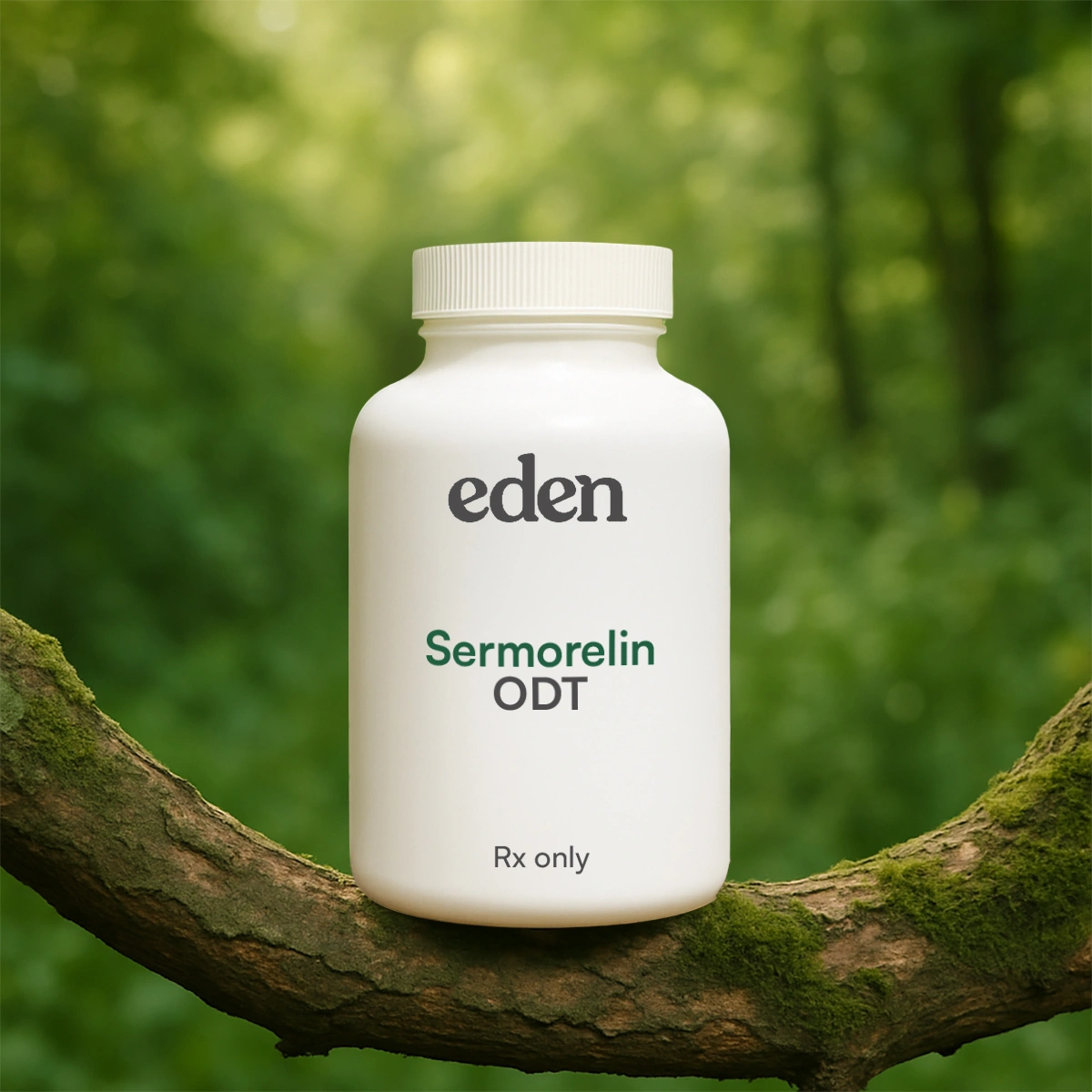Sermorelin Half-Life: How Long Does Sermorelin Stay in Your System?
Learn how long sermorelin stays in your system, its half-life, and how it affects growth hormone and IGF-1.
- Sermorelin has a very short half-life—about 10 to 20 minutes—but its effects on growth hormone release can last for several hours.
- After an injection, GH levels generally peak within 30 to 60 minutes, while the downstream hormone IGF-1 can remain elevated for much longer.
- Sermorelin stimulates your body’s own growth hormone production rather than replacing it directly, helping support a more natural, pulsatile pattern.
- When you stop sermorelin, the peptide itself clears within hours, and most people’s hormone levels return toward their individual baseline over time, though this can vary.
- Sermorelin isn’t right for everyone, and decisions about starting or stopping therapy should always be made with a licensed healthcare provider.
This article is for general informational purposes only and is not a substitute for professional medical advice, diagnosis, or treatment. Always talk with a licensed healthcare provider before starting, changing, or stopping any medication or therapy. Compounded medications are not FDA-approved and are prepared by a pharmacy for an individual patient pursuant to a prescription from a licensed clinician. They are not reviewed by the FDA for safety, effectiveness, or manufacturing quality.
What is Sermorelin?
When searching for ways to age gracefully, you might come across sermorelin. But how long does it actually stay in your body? And how often do you need to take it to see results?
Sermorelin is a synthetic peptide that signals your pituitary gland to release more of the growth hormone. Specifically, it’s a growth hormone-releasing hormone (GHRH) analog that mimics the natural GHRH produced by your hypothalamus.
This peptide includes the first 29 amino acids of the naturally occurring GHRH molecule, making it the shortest synthetic peptide to retain GHRH’s full biological activity. When administered, sermorelin binds to specific receptors in the pituitary gland, triggering the natural production and release of growth hormone into your bloodstream.
Unlike direct growth hormone replacement therapy, sermorelin stimulates your body’s endogenous growth hormone production. This approach maintains the natural cyclic release pattern of the growth hormone, which typically occurs in bursts throughout the day and night, with the highest peaks during deep sleep.
Sermorelin is typically administered through subcutaneous injection, usually before bedtime to align with the body’s natural growth hormone release patterns. The dosage and frequency depend on individual needs and medical conditions, but most protocols involve daily injections.
Sermorelin was originally developed for the diagnosis and treatment of certain forms of growth hormone deficiency, especially in children, and in some cases, it may be prescribed by licensed providers for adults when clinically appropriate.
{{primary-cta}}
Benefits of Sermorelin
Sermorelin’s use extended beyond growth hormone deficiency treatment in the early to mid-2000s. Researchers and other experts alike found that it had the potential to help with age-related growth hormone decline and offer other wellness benefits.
These potential benefits may include:
- Improved muscle mass
- Support of quality sleep
- Enhanced energy and performance
- Better overall well-being
- Improved skin elasticity
- Support for healthy body composition (when combined with diet and exercise)
- Support for bone health
But how long does sermorelin stay in your system? Can it have any side effects?
What is the Half-Life of Sermorelin?
Sermorelin has a short half-life of just 10 to 20 minutes when administered via subcutaneous injection. This means that within 10 to 20 minutes of injection, half of the sermorelin in your bloodstream is broken down and eliminated by your body.
While the peptide itself is rapidly cleared from your system, its biological effects last much longer. After a sermorelin injection, growth hormone levels typically peak within 30 to 60 minutes and can remain elevated for several hours afterward.
The growth hormone released through this process subsequently stimulates the liver to produce insulin-like growth factor 1 (IGF-1), a hormone with a longer half-life—generally 12 to 24 hours. This extended activity of IGF-1 is thought to help support many of the physiological processes associated with sermorelin’s use, such as tissue repair and metabolic regulation.
Because of its short half-life, sermorelin is typically administered once daily, usually before bedtime. This timing takes advantage of the body’s natural growth hormone surge during sleep while ensuring the peptide doesn't interfere with the body’s daytime hormone rhythms. Some protocols may involve twice-daily dosing, but this should always be determined by a healthcare provider based on your specific needs and treatment response.
{{primary-cta}}
What Happens When You Stop Sermorelin?
When you discontinue sermorelin therapy, the peptide itself clears from your system within hours due to its short half-life.
However, it’s worth noting that the exact timeline for what happens can vary from person to person. Ultimately, it depends on many factors such as age, overall health, and how long you’ve been using sermorelin.
In short, sermorelin works by stimulating the pituitary gland to release growth hormone, not by replacing it directly. Once that stimulation stops, the pituitary generally resumes its natural rhythm.
Because sermorelin supports your body’s existing hormone pathways, discontinuing treatment is not typically associated with withdrawal effects or hormone suppression. Most people’s growth hormone levels return to their individual baseline within a short period, but this can vary. However, maintaining healthy habits developed during treatment—such as regular exercise, balanced nutrition, and quality sleep—can continue to support overall well-being after therapy concludes.
Final Thoughts
Either way, it’s always important to use sermorelin with proper medical supervision. It’s not right for everybody.
Side effects can include headaches, dizziness, injection site reactions or irritation, nausea, and fatigue. But for some individuals, this can be more serious, including cardiovascular or metabolic implications. Thus, determining if it’s right for you with your healthcare provider is the very first step when adding sermorelin to your wellness toolbox.
Disclaimer: The FDA does not approve compounded medications for safety, quality, or manufacturing. Prescriptions and a medical evaluation are required for certain products. The information provided on this blog is for general informational purposes only. It is not intended as a substitute for professional advice from a qualified healthcare professional and should not be relied upon as personal health advice. The information contained in this blog is not meant to diagnose, treat, cure, or prevent any disease. Readers are advised to consult with a qualified healthcare professional for any medical concerns, including side effects. Use of this blog's information is at your own risk. The blog owner is not responsible for any adverse effects or consequences resulting from the use of any suggestions or information provided in this blog.
Eden is not a medical provider. Eden connects individuals with independent licensed healthcare providers who independently evaluate each patient to determine whether a prescription treatment program is appropriate. All prescriptions are written at the sole discretion of the licensed provider. Medications are filled by state-licensed pharmacies. Please consult a licensed healthcare provider before making any medical decisions.
Frequently asked questions
Blog Components



References
Ishida, J., Saitoh, M., Ebner, N., Springer, J., Anker, S. D., & Von Haehling, S. (2020). Growth hormone secretagogues: history, mechanism of action, and clinical development. JCSM Rapid Communications, 3(1), 25–37. https://doi.org/10.1002/rco2.9
Mayo Clinic. (2025). Sermorelin (injection route). https://www.mayoclinic.org/drugs-supplements/sermorelin-injection-route/description/drg-20065923
Prakash, A., & Goa, K. L. (1999). Sermorelin: a review of its use in the diagnosis and treatment of children with idiopathic growth hormone deficiency. BioDrugs : clinical immunotherapeutics, biopharmaceuticals and gene therapy, 12(2), 139–157. https://doi.org/10.2165/00063030-199912020-00007
Yuen, K. C. J., Hjortebjerg, R., Ganeshalingam, A. A., Clemmons, D. R., & Frystyk, J. (2024). Growth hormone/insulin-like growth factor I axis in health and disease states: an update on the role of intra-portal insulin. Frontiers in endocrinology, 15, 1456195. https://doi.org/10.3389/fendo.2024.1456195
The wellness insight you need, without the noise.














